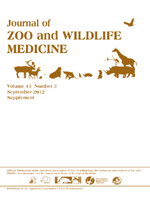Necropsies of two browser rhinoceroses, African black (Diceros bicornis) and Sumatran (Dicerorhinus sumatrensis), often reveal extensive iron-pigment deposition in various tissues. This condition (hemosiderosis) has not been observed in species that are natural grazers, African white (Ceratotherium simum) and Asian greater one-horned (Indian; Rhinoceros unicornis), nor in any species free ranging in the wild. The causes, clinical significance, and consequences of captivity-acquired hemosiderosis have remained controversial despite two decades of compelling evidence that iron tends to accumulate logarithmically in all members of affected species in proportion to periods of expatriation; total-body iron loads can reach 10-fold in less than 3 yr and eventually exceed reference ranges by two to three orders of magnitude; iron overburdens are accompanied by laboratory and histopathologic evidence of cellular injury, necrosis and other clinical consequences characteristic of chronic pathologic iron storage disorders (ISD) in humans and other species (hemochromatosis); and that ISD develops in many other exotic wildlife species displaced from their natural habitats. The historical evolution of evidence establishing the development of pathologic ISD in browser (but not in grazer) rhinoceroses and the possible relevance of ISD to other conditions affecting these two species will be reviewed. Evidence reviewed includes new as well as published data derived from quantitative measurements of iron analytes in sera and necropsy tissues and histopathologic evaluations of current and past necropsies of captive and free-ranging rhinoceroses of all four available species. The evolutionary, husbandry, and conservation implications of ISD in rhinoceroses are relevant to understanding ISD acquired by many other species of exotic wildlife when displaced from their natural environments.
How to translate text using browser tools
2 September 2012
REVIEW OF LABORATORY AND NECROPSY EVIDENCE FOR IRON STORAGE DISEASE ACQUIRED BY BROWSER RHINOCEROSES
Donald E. Paglia,
I-Hsien Tsu
ACCESS THE FULL ARTICLE
<
Previous Article
|
ferritin
hemochromatosis
hemosiderosis
iron
rhinoceros species





